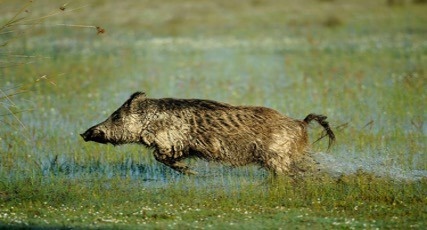The father of the black leg

29/04/2021
0 Comments
Discovered in Huelva the tracks of the ancestor of the Iberian pig, a wild boar weighing up to 300 kilos that took refuge from the ice in the southwest of the Iberian Peninsula with the last European Neanderthals, elephants, lions and leopards.
Around 106,000 years ago, while the rest of Europe survived buried under snow and glaciers, the southwest of the Iberian Peninsula, with a milder climate, was the refuge of the last Neanderthals and of the continent's megafauna, such as the prehistoric elephant. of “straight tusk” (Palaeoloxodon antiquus). In an area of coastal dunes, already fossilized and located on the limits of what is now Doñana, a gigantic specimen of wild boar, which at that time could weigh up to 300 kilos, left its mark. His lineage was called to become one of the most important gastronomic treasures in the world: that wild pig was the ancestor of the pata negra, the current Iberian breed.
The study of the fossilized tracks of these animals has allowed them to be classified worldwide as a new ichnogenus and icospecies and to identify the producer species. Its finding has been led by researchers Carlos Neto, from the Unesco Naturtejo Global Geopark and the University of Lisbon; Fernando Muñiz, from the University of Seville; Joaquín Rodríguez Vidal and Zain Belaústegui, from Huelva and Barcelona, respectively; together with other researchers from the aforementioned centers, from Coimbra and the National Museum of Gibraltar. The work has been covered in the international magazine specialized in paleontology Palaios.
The Asperillo cliff, located on the edge of Doñana and in the coastal enclave of Matalascañas (Almonte, Huelva), has become a mine for icnological research, the science that studies the traces and signs left by organisms in the past. in sediments and rocks. The storms of last winter uncovered numerous evidences of the passage of fauna through these sands more than 100,000 years ago, an open book about life in a paradisiacal area that sheltered enormous and apparently exotic animals in relation to current ecosystems.
“Since last spring, two research campaigns have been carried out and surprises continue to emerge. We had identified many types of footprints, of which we published an advance in the journal Quaternary Science Reviews , and now we are analyzing each of them in detail. Among those found, we have identified several wild boar, which we have analyzed with 3D modeling techniques and compared with other existing ones, to conclude that it is a new ichnogenus and icospecies: Suidichnus galani . Its unique characteristics, never described in the fossil record, indicate that it could be evidence of the origin of the Iberian pig ”, explains Muñiz, geologist, ichnologist and professor of the Crystallography and Mineralogy Area of the University of Seville.
The trapezoidal shape of the outline of the footprints, with long comma-shaped impressions, show the kinship with the Iberian race, although the ancestor of the current black leg was possibly larger, weighing more than three times that of the current common wild boar. Their hooves left footprints of a maximum of 125 millimeters long and 75 millimeters wide. "The remarkable large size" of at least one of the producers, according to the research, is associated with an "ecomorphological adaptation of wild boars to the abundance of resources and the pressure of predators during the last interglacial period."
In this sense, one of the hypotheses that the study points out, to explain the apparent gigantic size of the wild boar in Matalascañas, is that the period corresponding to the age of the investigated tracks was characterized by a “great diversity and intensity of predators”. The wild boar, in the period prior to the massive extinction of the megafauna, which would have occurred until the end of the Pleistocene, lived with leopards, lions, wolves, hyenas and Neanderthal humans, for whom it was a common prey. The presence of wolves contemporary to this wild boar species, prior to the Iberian breed, has also been evidenced by the discovery of fossil footprints in the area studied by the researchers.
Regardless of the size, which was reduced due to the change in environmental conditions, the relationship with the current Iberian pig is evident, according to the study. "The great Sus scrofa scrofa (wild boar) identified in Matalascañas corresponds to the first known evidences for this subspecies in Iberia", concludes the investigation.
From Asia to Huelva
The wild boar is one of the species with the widest geographical distribution (present on all continents except Antarctica) due to its ability to adapt to environmental conditions and its general eating habits. The specimens from the southwest of the peninsula share the same origin, as explained by Carlos Neto De Carvalho , lead author of the research, geologist, paleontologist and scientist at the Dom Luiz Institute (University of Lisbon) and the Naturtejo Geopark (Portugal): “The evolutionary origins of the Sus are in the east of Asia for 4.2 million years, from where it experienced a wide expansion by the Asian continent, the Middle East and North Africa. It reached Europe at least 1.1 million years ago. The only currently existing species, Sus scrofa or Eurasian wild boar, in its multitude of subspecies, prospered thanks to an excellent adaptation to environmental changes recorded in such different geographies and includes the variety domesticated by man Sus scrofa domesticus , the pig ”.
“At the peak of the last glacial period, Sus scrofa scrofa is restricted to the southernmost areas of Europe: southern France and the Iberian, Italian and Balkan peninsulas. From there, from the last 10,000 years, it will genetically recolonize the northernmost parts of Europe, adapting to different environmental conditions and giving rise to the variety that exists today. In the Iberian peninsula, the most common subspecies, scrofa , and a smaller one, baeticus, an ecotype discussed by the scientific community that subsists in places like Doñana, ”explains Neto de Carvalho.
A dwindling giant
“The initial populations of Sus scrofa were very large. Some Matalascañas wild boar tracks belong to huge specimens whose dimensions only have current comparison with the subspecies that live in the Urals or in Siberia. In the last interglacial period, when the paleosurface with the Huelva footprints that we are now studying was formed, the climate was more humid and made possible a forest close to wetlands or river courses, with more food availability for wild boars. However, in the last glacial maximum period, between 30,000 and 18,000 years ago, when the Pleistocene megafauna was extinguished by climatic rigors and hunting by hominids, wild boars respond with a reduction in girth and thrive in climatic oases. from southern Europe, adapting to a pronounced loss of resources, with the replacement of forest areas by steppes and grasslands ”, explains the researcher.
From this adaptation arise the current wild boars of the Iberian Peninsula, whose weight ranges between 75 and 85 kilograms for males. In Doñana , the Sus scrofa baeticus specimens are around 54 kg because in that area, according to Neto, they live in the thickets and pine forests of the south of the national park, where the amount and diversity of food available is less. "However, currently, the corpulence of wild boar tends to increase in regions with less population density and hunting pressure," he adds.
From wild boar to pig
The Portuguese researcher points out that domestication took place in the last 10,000 years, "when human communities dispersed pigs throughout Europe and Asia as a very important food source for sedentary communities, which are experiencing population growth."
“In this way, we can say that the origins of the pig and the famous and delicious Iberian ham are in the wild boars that left their footprints in Matalascañas , similar to other fossil traces of the early Upper Pleistocene found in the Iberian Peninsula and that are the basis of the evolutionary lineage of the current pigs ”, concludes Neto de Carvalho, who warns of the importance of the knowledge of the“ biotic impacts originated during the last great climatic changes and that still affect us ”.
The discoverer of the footprint
Icnology has particular rules and the traces or marks left by the fauna bear its own name, rooted in the classical system of biological classification of Linnaeus (1735). In this way, the trail found in Matalascañas has been baptized as Suidichnus galani ichnospecies. This surname is the recognition of José María Galán , guide of the Doñana National Park who works in the National Plan to Combat Illegal Trafficking and International Poaching (Tifies). This tracker of the traces of history was the first to warn of the uniqueness of the vestige found in the sands of Huelva.
“ Ana Mateo and Dolores Cobo , biologists and workers from the Doñana park, sent me a photo on WhatsApp. It all started there, ”recalls Galán. The special characteristics of the footprint did not go unnoticed by this experienced trail seeker, who understands his art as a means to be part of nature. "I'm like space probes sending photos and data of what I find," he jokes.
The information on the traces was shared with Fernando Muñiz, who immediately began the icnological study with Carlos de Neto de Carvalho and the rest of the team.
Galán , also the author of the representations of the animal that left its mark on Huelva , explains that the change in the dynamics of the coastline revealed the fragile area of fossil dunes where the signature of the prehistoric fauna had remained. "The study area, which began as about 40 square meters, has multiplied, which shows that we have to rediscover our heritage every day and urgently," he says. The action of wind, rain, visitors to the area and the sea put at risk the durability of the traces found in the materials of the paleontological area.
“The tracks provide a lot of information about the animal, its size, its behavior. It's atavistic. Children do it naturally. It is intrinsic to man to link the brand to the animal that has generated it. It requires imagination and that is only proper to man. A dog, if the trail has no odor, passes through the track without perceiving it. Man, who has an angle of vision that facilitates tracking, is able to reconstruct the animal that has left the mark or mark and what he was doing at that time ”, he explains.
His tracker and artistic skills have been fundamental in this investigation, whose work has been recognized with the dedication of the name of the ichnospecies.
